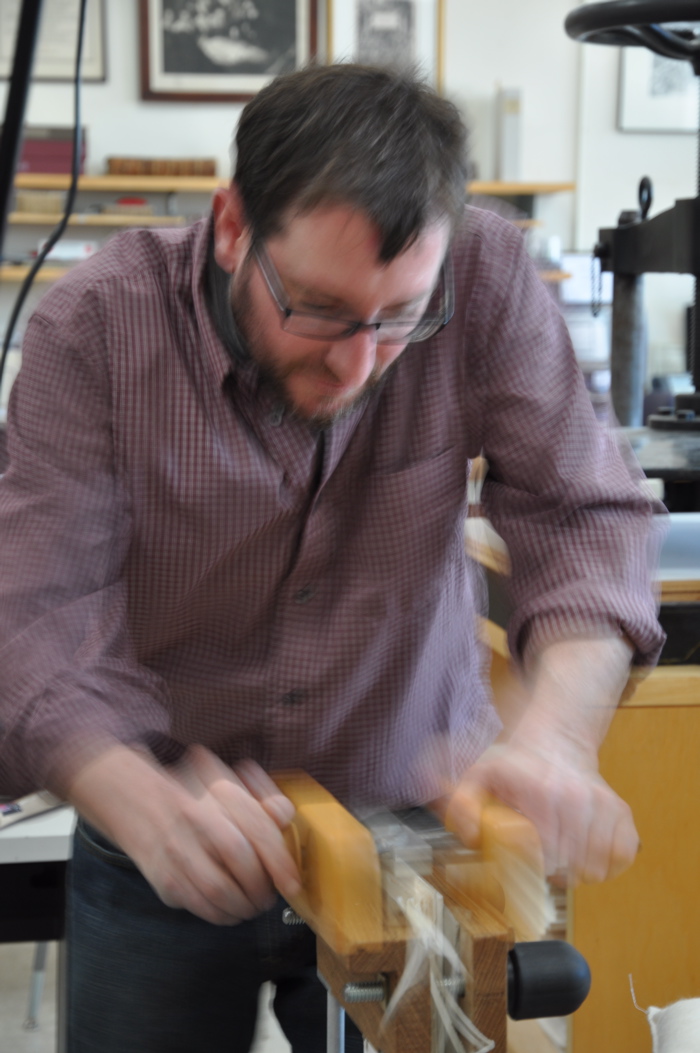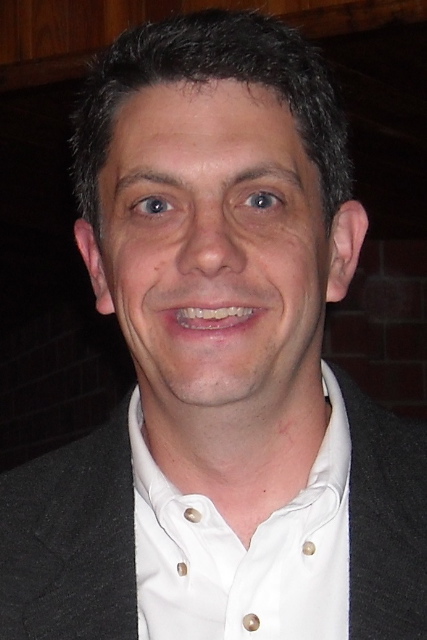Word Work
In This Issue
Click on the link above to find the image that introduces this issue. It is “The Bookbinder,” one of 97 engravings in The Book of Trades published in 1694 in Holland by Jan Luyken (1649-1712), the prolific Mennonite engraver, assisted by his son Casper (1672-1708). The book of engravings has become Luyken’s most famous work, and the Bookbinder image has become an icon for book-binders and book conservators worldwide.
No doubt an idealized depiction, the Bookbinder seems to have reason to be satisfied, even happy, in his work. The room is spacious. The upper windows let in a lot of light and the lower windows and doors are open, letting in fresh air. In the left foreground, the worker sews signatures on a sewing frame, glue pot on the floor. In the back, the man beats the signatures prior to sewing. The round-blade “plow” at bottom right is for trimming book edges. The shelves at the left are crammed with books. Perhaps the Bookbinder is himself an avid reader.
He is doing “word work,” the theme of this issue of the Journal of the Center for Mennonite Writing. Perhaps he can represent most of the readers of this journal—poets, fiction writers, memoirists, bloggers, journalists, readers—anyone who loves words and might yearn to earn a living in some way associated with words. All of us might hope somehow, someday to attain the goal of the speaker in Robert Frost’s poem, “Two Tramps in Mudtime,” who says: “My object in living is to unite / My avocation and my vocation.”
This issue presents three Journal readers who, in very different ways, earn their living by means of words and books. Jeff Peachey is The Bookbinder’s closest descendant, since he has mastered the craft of book conservation and earns his living by it in New York City. We can tell he loves to hold and preserve the physical vessels of writing—books and pamphlets—by his clear and precise attention to the physical and historical details that the books themselves embody. Even more of his craft and insight is available through his blog that is included in the links on the homepage of the CMW website.
Marta Brunner manipulates books in a similarly meticulous way, but more theoretically, as an academic bibliographer for the graduate library at the University of California at Los Angeles. Her academic background is in English, rhetoric and the history of consciousness, not in library science, which gives hope to all that our training does not limit us to one vocation.
At the opposite pole from Peachey, who preserves books and their history, is Jane Hiebert-White, who as Executive Publisher of the journal Health Affairs, tries to keep up with the decline of words in print and the rise of words in digital form. Despite Jane’s heavy workload in Washington, DC, during the recent flurry of discussions of health care reform, she was able to rise above the chaos and craft her fine essay—like many writers, just in the nick of time.
Dr. Samuel Johnson, a lexicographer, defined his own “word work” as that of “a harmless drudge.” To some degree, the intense, minute scrutiny that our three authors’ jobs require fits that disarming description. But ask all of our writers if they enjoy their work, and you will, I am sure, receive a positive response.
One caveat: Nick Lindsay, the poet and mentor who was honored at the Mennonite/s Writing Conference in 2006 at Bluffton College, always urged his creative writing students NOT to try to earn their living by writing literature or teaching creative writing, lest the job ruin the art. Nick eventually left his teaching position at Goshen College and returned to Edisto Island, South Carolina, where he built winding stairs and fiberglass boats. Perhaps, in light of his warning, the three essayists in this issue have found the golden mean of “word work” between the extremes of “mere work” and “literature.”
This issue concludes with a series of linked poems by David C. Wright. He is the “Featured Poet” for this February 2010 issue, to be followed by Sara Klassen in May and Jeff Gundy in July. Wright’s five “Sarabandes” represent a new direction in his published poems. Instead of the sharp, chatty, witty and always insightful poems that we have enjoyed earlier, here he experiments with pure lyricism and emotion, responding to performances of cello music by Bach. The poems are examples of ekphrastics, or the interplay between one artistic media and another, in this case music and poetry.
The Bookbinder engraving that introduces this issue is also ekphrastic art, since it integrates image with poetry, creating a kind of Renaissance emblem. The Luyken text has been newly translated by Jan Gleysteen and Leonard Gross:
The Eye of the Eternal Being,
Can read the book of your heart.
If knowledge were hidden in secret corners,
Showing us the way to heaven,
It would be worth searching the world for it;
But now it has been clearly told to humankind,
In the Holy, God-given Book. Respond to it by holy living!
Ervin Beck, Editor
In this issue:
-
0
read more

Outside of the Text
by Jeffrey S. PeacheyA book conservator often enters into public perception heavily colored by, and often confused with, romantic notions of a “Master Craftsman,” “Master Bookbinder” or “Master Restorer.” In a world where many use their hands only to tap at a keyboard or lift a cup of coffee, the idea of a craftsman seems refreshingly simple, a bit anachronistic, very poetic and entirely appealing. Fortunately (or perhaps unfortunately!) these romantic ideas of a bookbinder bear little resemblance to what I do.
Although the terminology is somewhat debatable, in North America a bookbinder is usually someone who makes new fine bindings, or binds …
-
0
read more

A Series of Fortunate Events: Becoming an Academic Librarian
by Marta BrunnerI didn't set out to be an academic librarian. In fact, one might say that the option was often literally staring me in the face, but it never occurred to me to consider librarianship as a career. Only through a series of fortunate events did I end up in what I think is my perfect job.
Why do I like academic librarianship so much? I get to teach, I get to do research, I get to write, I get to buy books and scholarly resources. I get to bring order to apparent chaos. I get to work with people in …
-
0
read more

Publishing: The Seeds of New Growth
by Jane Hiebert-WhiteSometimes change creeps up on you, slowly, without clear signposts marking the shift from point A to point B. Other times, change detonates – blasting a hole in what was and clearing the way for the new.
From my vantage point as a publisher at a scholarly journal in 2010, the bomb of disruptive innovation has gone off. The casualty list in the world of publishing is staggering: newspapers, newsweeklies, journals, consumer magazines.
“Not Gourmet,” I moan! I have box upon box of back issues. Okay, they’re up in the attic. At my parents’ house. I can always go …
-
0
read more

My Small Books of Bach
by David Wright"A real diehard, indestructible, irresolvable obsession in a poet is nothing less than a blessing," writes Tony Hoagland. "The poet with an obsession never has to search for subject matter. It is always right there, welling up like an Artesian spring on a piece of property with bad drainage.
- Tony Hoagland, Real Sofistikashun
As I type this, music pours through my headphones, a Bach suite for unaccompanied cello, recorded by the great Pablo Casals in the middle of the last century. Hearing Casals play on my iPod, I can’t help but think of the time I heard this same …
-
0
read more

Five Sarabandes
by David WrightPoems by David Wright